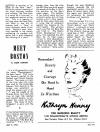
Home Page Meet Boston Menu Index
|
MEET BOSTON Friday, May 8, 1942 in What's New In Town W. J. Sidis |
Boston is peculiar in its use of the word “fens.” While the normal meaning of the word indicates swamps and marshes, the Fens here is a name for a fine park in the residential section of the city. This in its memory of the time when the Back Bay, just filled in, was full of swampy land―“fens” in every dictionary sense of the word. Boston’s park planning resulted in not merely converting its marshes into parks, but even in changing the meaning of a word.
*
It is a full generation since the name “Cambridgeport” has been heard. That name was formerly applied to the Kendall and Central Squares district. The name is a relic of a time when the route now used by the Cambridge Subway, from Central to the bridge, was waterfront―when the present site of M. I. T. was the middle of the Charles River, and when the river at high tide reached near Central Square, as witnessed by the name of River Street. The name of Cambridgeport is gone with the rest.
*
It may be hard to believe now, but a century ago the name “Back Bay” was heard of mainly in connection with the expression ‘the Back Bay nuisance.” The fact is, though, that, from the time the Mill Dam was built across the mouth of the bay in 1821, the pollution of the Bay’s water began. The addition of two branch dams and two railroad trestles did not help matters a bit in that regard, and for forty years there was a rising tide of complaint against the menace to the city’s health. The ultimate result was that the Back Bay was filled in. The Boston water Development Company, that operated the Mill Dam for its tidal power, turned to land development instead, and built up the Back Bay residential region where before had been “the Back Bay nuisance.” Some parts, though out near Brookline Avenue, retained the old pestilential atmosphere till recent years, when the region was cleaned out for occupation by medical buildings and hospitals.
*
That convenient terminology referring to “North Station” and “South Station,” is believed to have been started by the opening of the Atlantic Avenue elevated loop in 1901. Neither station was ever officially called “North” or South”; but, with the first loop of rapid transit trains, passing both of the new union terminal depots, these seemed the most convenient designations.